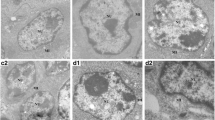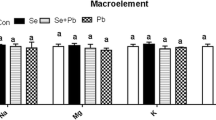Abstract
The aim of this study was to investigate the ameliorative effects of selenium-enriched yeast (Se-yeast) on the inflammatory damage induced by lead (Pb) in chicken skeletal muscles. A total of 108 1-day-old broiler chickens were randomly allocated into four groups (n = 27/group): the control group (C group), the Se-yeast-supplemented group (Se group), the lead-treated group (Pb group), and finally the Se- and Pb-combined group (Pb/Se group). The C group was fed with a basic diet comprising 0.049 mg/kg Se and 0.1 mg/kg Pb while the Se group was fed a Se-yeast diet containing 0.30 mg/kg Se and 0.1 mg/kg Pb. Similarly, the Pb group was fed a Pb acetate diet containing 0.049 mg/kg Se and 350 mg/kg Pb while the Pb/Se group was fed with a Se-yeast diet containing 0.30 mg/kg Se and 350 mg/kg Pb. On days 7, 21, and 35 after commencing the experiment, nine chicks belonging to each group were euthanized and the samples were analyzed by employing the techniques of inductively coupled plasma mass spectrometry and real-time quantitative PCR, along with Western blotting. The results indicated that excess Pb increased the nitric oxide concentration, enhanced the activity of inducible nitric oxide synthase (iNOS), and the mRNA levels of interleukin 1β (IL-1β), interleukin 4 (IL-4), interleukin 10 (IL-10), and interferon gamma (IFN-γ) in a time-dependent manner. Further, it was found that Se reduced damage caused by Pb by decreasing the expression of inflammatory factors in chicken skeletal muscles. Taken together, the results from this study provide the theoretical basis for an alleviate effect of Se on Pb-induced inflammatory damage in chicken skeletal muscles, mediated by inhibiting the Ras/extracellular signal-regulated kinase (ERK) pathway and the inflammatory factors.






Similar content being viewed by others
References
Sun GX, Chen Y, Liu CP, Li S, Fu J (2016) Effect of selenium against Lead-induced damage on the gene expression of heat shock proteins and inflammatory cytokines in peripheral blood lymphocytes of chickens. Biol Trace Elem Res 172(2):474–480
Han Y, Li C, Mingjun S, Wang Z, Jiang N, Sun D (2017) Antagonistic effects of selenium on lead-induced autophagy by influencing mitochondrial dynamics in the spleen of chickens. Oncotarget 8(20):33725–33735
Li X, Xing M, Chen M, Zhao J, Fan R, Zhao X, Cao C, Yang J, Zhang Z, Xu S (2017) Effects of selenium-lead interaction on the gene expression of inflammatory factors and selenoproteins in chicken neutrophils. Ecotoxicol Environ Saf 139:447–453
Wang H, Li S, Teng X (2016) The antagonistic effect of selenium on Lead-induced inflammatory factors and heat shock proteins mRNA expression in chicken livers. Biol Trace Elem Res 171(2):437–444
Kieliszek M, Błażejak S, Gientka I, Bzducha-Wrobel A (2015) Accumulation and metabolism of selenium by yeast cells. Appl Microbiol Biotechnol 99(13):5373–5382
Kieliszek M, Błażejak S (2016) Current knowledge on the importance of selenium in food for living organisms: a review. Molecules 21(5):609
Liu Z, Yao X, Du J, Song B, Zhang F (2017) Selenium deficiency augments the levels of inflammatory factors and heat shock proteins via the redox regulatory pathway in the skeletal muscles of mice. Biol Trace Elem Res 182(5):309–316
Liu Z, Qu Y, Wang J, Wu R (2016) Selenium deficiency attenuates chicken duodenal mucosal immunity via activation of the NF-κb signaling pathway. Biol Trace Elem Res 172(2):465–473
Yang T, Zhao Z, Liu T, Zhang Z, Wang P, Xu S, Lei XG, Shan A (2017) Oxidative stress induced by Se-deficient high-energy diet implicates neutrophil dysfunction via Nrf2 pathway suppression in swine. Oncotarget 8(8):13428–13439
Kieliszek M, Błażejak S, Bzducha-Wróbel A, Kot AM (2018) Effect of selenium on lipid and amino acid metabolism in yeast cells. Biol Trace Elem Res 1. https://doi.org/10.1007/s12011-018-1390-2.
Kieliszek M, Błażejak S (2013) Selenium: significance, and outlook for supplementation. Nutrition 29(5):713–718
Kieliszek M, Błażejak S, Bzducha-Wróbel A, Kurcz A (2016) Effects of selenium on morphological changes in Candida utilis ATCC 9950 yeast cells. Biol Trace Elem Res 169(2):387–393
Ojeda ML, Nogales F, Murillo ML, Carreras O (2012) Selenium or selenium plus folic acid-supplemented diets ameliorate renal oxidation in ethanol-exposed pups. Alcohol Clin Exp Res 36(11):1863–1872
Liu Y, Qiu C, Li W, Mu W, Li C, Guo M (2016) Selenium Plays a Protective Role in Staphylococcus aureus-Induced Endometritis in the Uterine Tissue of Rats. Biol Trace Elem Res 173(2):345–353
Chen J, Pan T, Wan N, Sun Z, Zhang Z, Li S (2017) Cadmium-induced endoplasmic reticulum stress in chicken neutrophils is alleviated by selenium. J Inorg Biochem 170:169–177
Zheng S, Song H, Gao H, Liu C, Zhang Z, Fu J (2016) The antagonistic effect of selenium on Lead-induced inflammatory factors and heat shock protein mRNA level in chicken cartilage tissue. Biol Trace Elem Res 173(1):177–184
Wang X, An Y, Jiao W, Zhang Z, Han H, Gu X, Teng X (2017) Selenium Protects against Lead-induced Apoptosis via Endoplasmic Reticulum Stress in Chicken Kidneys. Biol Trace Elem Res 26:354–363. https://doi.org/10.1007/s12011-017-1097-9
Liu CM, Sun YZ, Sun JM, Ma JQ, Cheng C (2012) Protective role of quercetin against lead-induced inflammatory response in rat kidney through the ROS-mediated MAPKs and NF-κB pathway. Biochim Biophys Acta 1820(10):1693–1703
Ishida K, Kotake Y, Sanoh S, Ohta S (2017) Lead-Induced ERK Activation Is Mediated by GluR2 Non-containing AMPA Receptor in Cortical Neurons. Biol Pharm Bull 40(3):303–309
Zhao D, Zhang X (2017) Selenium Antagonizes the Lead-Induced Apoptosis of Chicken Splenic Lymphocytes In Vitro by Activating the PI3K/Akt Pathway. Biol Trace Elem Res 5:119–129. https://doi.org/10.1007/s12011-017-1088-x
Huang JQ, Ren FZ, Jiang YY, Xiao C, Lei XG (2015) Selenoproteins protect against avian nutritional muscular dystrophy by metabolizing peroxides and regulating redox/apoptotic signaling. Free Radic Biol Med 83:129–138
Yuan D, Zhan X, Wang Y (2011) Effects of selenium sources and levels on reproductive performance and selenium retention in broiler breeder, egg, developing embryo, and 1-day-old chick. Biol Trace Elem Res 144(1–3):705–714
Kieliszek M, Błażejak S, Kurek E (2017) Binding and conversion of selenium in Candida utilis ATCC 9950 yeasts in bioreactor culture. Molecules 22(3):352
Peirson SN, Butler JN, Foster RG (2003) Experimental validation of novel and conventional approaches to quantitative real-time PCR data analysis. Nucleic Acids Res 31:e73
Zhang H, Wang S, Zhang XX, Ji W, Song F, Zhao Y, Li J (2016) The amyR-deletion strain of aspergillus Niger CICC2462 is a suitable host strain to express secreted protein with a low background. Microb Cell Factories 28(15):68. https://doi.org/10.1186/s12934-016-0463-1.
Liu T, Yang T, Xu Z, Tan S, Pan T, Wan N, Li S (2018) MicroRNA-193b-3p regulates hepatocyte apoptosis in selenium-deficient broilers by targeting MAML1. J Inorg Biochem 186:235–245
Al-Rasheed NM, Attia HA, Mohamed RA, Al-Rasheed NM, Al-Amin MA (2013) Preventive effects of selenium yeast, chromium picolinate, zinc sulfate and their combination on oxidative stress, inflammation, impaired angiogenesis and atherogenesis in myocardial infarction in rats. J Pharm Pharm Sci 16(5):848–867
Hamid M, Abdulrahim Y, Liu D, Qian G, Khan A, Huang K (2018) The Hepatoprotective Effect of Selenium-Enriched Yeast and Gum Arabic Combination on Carbon Tetrachloride-Induced Chronic Liver Injury in Rats. J Food Sci 83(2):525–534
Gao Z, Li J, Song X, Zhang J, Wang X, Jing H, Ren Z, Li S, Zhang C, Jia L (2017) Antioxidative, anti-inflammation and lung-protective effects of mycelia selenium polysaccharides from Oudemansiella radicata. Int J Biol Macromol 104(Pt A):1158–1164
Cao C, Luo J, Li X, Zhang M, Zhang H, Zhang J, Wang K (2018) Selenium-Rich Yeast Protects Against Aluminum-Induced Renal Inflammation and Ionic Disturbances. Biol Trace Elem Res. 30. https://doi.org/10.1007/s12011-018-1324-z
McKelvey SM, Horgan KA, Murphy RA (2015) Chemical form of selenium differentially influences DNA repair pathways following exposure to lead nitrate. J Trace Elem Med Biol 29:151–169
Gao H, Liu CP, Song SQ, Fu J (2016) Effects of dietary selenium against Lead toxicity on mRNA levels of 25 Selenoprotein genes in the cartilage tissue of broiler chicken. Biol Trace Elem Res 172(1):234–241
Jin X, Liu CP, Teng XH, Fu J (2016) Effects of dietary selenium against Lead toxicity are related to the ion profile in chicken muscle. Biol Trace Elem Res 172(2):496–503
Xu Z, Jin X, Pan T, Liu T, Wan N, S L (2017) Antagonistic effects of selenium on cadmium-induced apoptosis by restoring the mitochondrial dynamic equilibrium and energy metabolism in chicken spleens. Oncotarget 8(32):52629–52641
Bi CL, Wang H, Wang YJ, Sun J, Dong JS, Meng X, Li JJ (2016) Selenium inhibits Staphylococcus aureus-induced inflammation bysuppressing the activation of the NF-κB and MAPK signalling pathways in RAW264.7 macrophages. Eur J Pharmacol 780:159–165
An X, Zhou A, Yang Y, Wang Y, Xin R, Tian C, Wu Y (2016) Protective Effects of Gallic Acid Against NiSO4-Induced Toxicity Through Down-Regulation of the Ras/ERK Signaling Pathway in Beas-2B Cells. Med Sci Monit 22:3446–3454
Tian L, Li W, Yang L, Chang N, Fan X, Ji X, Xie J, Yang L, Li L (2017) Cannabinoid Receptor 1 Participates in Liver Inflammation by Promoting M1 Macrophage Polarization via RhoA/NF-κB p65 and ERK1/2 Pathways, Respectively, in Mouse Liver Fibrogenesis. Front Immunol 28(8):1214
Acknowledgments
The authors wish to thank the study participants and Jilin University for their contributions to this study. All of the authors have read the manuscript and have agreed to submit it, in its current form, for consideration for publication.
Funding
This work was supported by grants from the Foundation Project of Heilongjiang province natural (No. H2017038), National key research and development program of the 13th five-year plan(2016YFD0501203), Heilongjiang University Students Innovation and Entrepreneurship Training Project (201810223079), and the Startup Foundation for the Doctors in Heilongjiang Bayi Agricultural University (Grant No. XDB-2017-18), and the School Cultivation Project Foundation in Heilongjiang Bayi Agricultural University (XZR2016-12).
Author information
Authors and Affiliations
Corresponding author
Ethics declarations
All experiments were approved by the Institutional Animal Care and Use Committee (Permission number: 22-05-01).
Conflict of Interest
The authors declare that they have no competing interests.
Additional information
Publisher’s Note
Springer Nature remains neutral with regard to jurisdictional claims in published maps and institutional affiliations.
The contribution of Liu Zhe, Zhang Feng, Lu Ping, and Zhao Rui co-together is equally important in this article.
Rights and permissions
About this article
Cite this article
Liu, Z., Zhang, F., Lu, P. et al. Selenium-Yeast Alleviated Inflammatory Damage Caused by Lead via Inhibiting Ras/ERK Pathway and Inflammatory Factors in Chicken Skeletal Muscles. Biol Trace Elem Res 190, 493–500 (2019). https://doi.org/10.1007/s12011-018-1558-9
Received:
Accepted:
Published:
Issue Date:
DOI: https://doi.org/10.1007/s12011-018-1558-9




